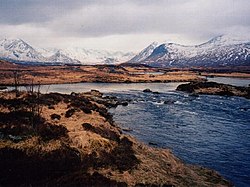
Back Rannoch Moor Afrikaans Rannoch Moor German Rannoch Moor Spanish Rannoch Moor Finnish Mòinteach Raineach Irish Mòinteach Raineach Scots/Gaelic Rannoch Moor Dutch Rannoch Moor Polish Раннох-Мур Russian Rannoch Muir SCO
| Rannoch Moor | |
|---|---|
| Mòinteach Raineach/Raithneach | |
 The Black Mount, seen over the wild landscape | |
| Location | West of Loch Rannoch, Scotland, UK |
| Coordinates | 56°39′15″N 4°35′37″W / 56.654112315228254°N 4.593733814613356°W |
| Designations | |
|---|---|
| Official name | Rannoch Moor |
| Designated | 5 January 1976 |
| Reference no. | 78[1] |
Rannoch Moor (/ˈrænəx/ ⓘ; Scottish Gaelic: Mòinteach Rai(th)neach) is an expanse of around 50 square miles (130 km2) of boggy moorland to the west of Loch Rannoch in Scotland, from where it extends into westerly Perth and Kinross, northerly Lochaber (in Highland), and the area of Highland Scotland toward its south-west, northern Argyll and Bute. Rannoch Moor is designated a Site of Special Scientific Interest (SSSI) and a Special Area of Conservation.[2] Much of the western part of the moor lies within the Ben Nevis and Glen Coe National Scenic Area,[3] one of 40 such areas in Scotland.[4]
It is notable for its wildlife, and is particularly famous as being the sole British location for the Rannoch-rush, named after the moor.[5] It was frequently visited by Horace Donisthorpe, who collected many unusual species of ants on the moor and surrounding hilly ground. Today it is still one of the few remaining habitats for Formica exsecta, the "narrow-headed ant", although recent surveys have failed to produce any sign of Formica pratensis, which Donisthorpe recorded in the area in the early part of the 20th century.
- ^ "Rannoch Moor". Ramsar Sites Information Service. Retrieved 25 April 2018.
- ^ 1331, 8348. Rannoch Moor, Scottish National Heritage Sitelink. Scottish National Heritage. 2012.
- ^ "Map: Ben Nevis and Glen Coe National Scenic Area" (PDF). Scottish Natural Heritage. December 2010. Retrieved 14 February 2018.
- ^ "National Scenic Areas". Scottish Natural Heritage. Retrieved 17 January 2018.
- ^ "Rannoch Moor Special Area of Conservation". Joint Nature Conservation Committee. Retrieved 26 April 2018.

